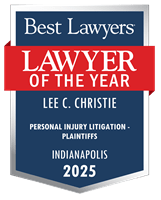Weather is a major contributor to car crashes across the country, but it does not give negligent drivers a free pass. Nationwide, approximately 21% of vehicle accidents are weather-related, which translates to nearly 1.2 million collisions every year. These crashes result in over 418,000 injuries and nearly 5,000 fatalities annually, according to the Federal Highway Administration. While weather can create hazardous driving conditions, drivers are still responsible for adjusting their behavior accordingly. When they fail to do so, accidents can result in serious injuries or fatalities and these drivers can be held legally accountable for their actions, regardless of the weather conditions.
If you were injured in an Indiana car accident during bad weather, remember that drivers must still adjust their behavior during snow, rain, or fog. At Christie Farrell Lee & Bell, we’ve successfully helped Indiana clients recover compensation in weather-related accidents, and we know how to challenge insurers when they try to avoid liability.
When Is Weather Considered a Factor in Indiana Car Accidents?
While poor visibility, slick pavement, and weather-related road hazards can contribute to crashes, these conditions don’t automatically absolve drivers of fault. Common weather-related conditions include:
- Black ice or snow-covered roads that reduce traction and increase stopping distance
- Hydroplaning on rain-soaked highways
- Fog or sun glare that limits a driver’s ability to see other vehicles or pedestrians
- Slippery bridge decks or shaded areas that remain icy longer than surrounding roads
Each of these conditions can impact driver response times and vehicle control, which is why weather plays a critical role in many car accident investigations. In Indiana, limited visibility from fog, darkness, or precipitation often exacerbates these risks. As detailed in our analysis of nighttime accident causes in Indiana, reduced visibility and poor weather often go hand-in-hand when contributing to serious collisions.
Speak with a personal injury lawyer today. Call: 317-488-5500
Can Drivers Still Be Liable During Poor Weather?
Drivers are expected to make thoughtful, proactive decisions in response to environmental hazards. If someone chooses to maintain their usual driving habits during adverse conditions—such as speeding, tailgating, or merging without signaling—that conduct may be deemed negligent regardless of what the weather was like.
For instance, a driver who skids into an intersection because they didn’t begin braking early enough on icy pavement has failed to exercise proper caution. A motorist who drives without headlights during dense fog, despite significantly reduced visibility, is not only violating Indiana law but also putting others at unnecessary risk. These are situations where weather is a factor, but human decision-making is what ultimately leads to collisions.
Other examples of negligent behavior in poor weather include:
- Proceeding through intersections without checking for black ice or residual snow buildup
- Failing to replace worn windshield wipers or maintain clear sightlines, especially during freezing rain
- Driving with snow-covered mirrors or lights that obscure awareness and make it difficult for others to see the vehicle
- Braking abruptly on wet roads without accounting for reduced tire traction, causing spinouts or rear-end impacts
- Making turns too sharply or too quickly when road surfaces are slick
Liability in these cases hinges on a principle known as “failure to adjust.” If a reasonable driver would have taken additional precautions in the same conditions and the defendant did not, then they can still be held financially responsible for resulting injuries.
Courts and insurance adjusters also examine whether the driver had a history of ignoring traffic safety rules. A pattern of careless driving can support claims of recklessness or enhance the strength of a personal injury case. It may even open the door to punitive damages in rare cases, depending on the severity of the misconduct.
Complete a Free Case Evaluation form now
How Insurance Companies Use Weather to Deny or Reduce Claims
One of the first tactics insurance companies use when bad weather is involved is to argue that the conditions, not the driver, were to blame. This strategy often aims to reduce liability or justify denying your claim entirely. Without clear proof of negligence, insurers may assert that the crash was simply unavoidable.
To combat this, our team builds detailed cases using:
- Dashcam or surveillance footage that shows how the driver was behaving prior to the crash
- Skid marks and debris patterns that indicate speed and braking behavior
- Weather data and road condition reports from the time and location of the crash
- Accident reconstruction experts who can explain how proper driving could have avoided the collision
As Fort Wayne car accident lawyers, we routinely go up against these kinds of defenses. Our goal is to show that the driver failed to meet their duty of care, even in poor conditions, and to ensure you aren’t penalized for weather they should have anticipated and accounted for.
Click to contact us today
Should I Get a Lawyer for a Weather-Related Crash That Wasn’t My Fault?
It’s common for people to assume that no one can be held responsible when weather plays a role. But that’s not how Indiana law works. Drivers are expected to exercise reasonable care, and failing to do so, even in a storm or snow squall, can still result in legal liability.
An experienced personal injury attorney in Fort Wayne can:
- Investigate whether the other driver failed to adapt to the conditions
- Collect and preserve key evidence like dashcam video or weather data
- Push back against insurers who claim the weather was solely at fault
- Calculate a full damages package that includes medical expenses, lost wages, and pain and suffering
If you’ve been injured in a crash during bad weather, don’t assume you’re out of options. Contact us today for a free consultation. Our experienced car accident attorneys at Christie Farrell Lee & Bell are ready to investigate your case, gather critical evidence, and fight for the recovery you deserve.
Call 317-488-5500 or complete a Free Case Evaluation form



